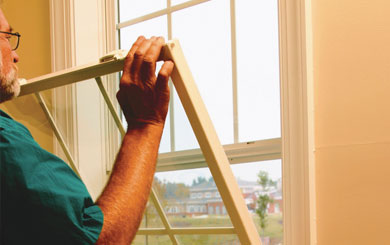
Q: We need replacement windows for our home, but every salesman makes his sound like the best and most efficient. How do I choose among the various frame materials, styles and glass types?
A: It can be extremely difficult to sort through all the sales and marketing hype to make the proper replacement window decision, and there are many absurd claims out there.
First, it’s important to note that because windows are expensive, energy efficiency should not be the only reason to buy new ones. Other efforts will save more money, and you can visit EnergySavers.gov to find ways to make your existing windows more energy efficient. But if you truly need new windows, there are some other considerations.
Proper selection depends on the characteristics of the window, the specific house, and your lifestyle. What is best for your next door neighbor may not be best for you. For example, you may want a view of a particular outdoors area or springtime ventilation, whereas your neighbor may keep the blinds closed and use air-conditioning continuously.
The main criteria for selecting replacement windows are frame material, window style, and glass type. From the energy efficiency standpoint, the glass type and window style are more important than the frame material, which has a greater effect on functionality, durability, maintenance and appearance.
FRAME MATERIALS
The most common frame materials for residential windows are vinyl, fiberglass, wood, and clad wood.
Vinyl is energy efficient, virtually maintenance free, and made to the precise dimensions of the window opening instead of having to shim out standard sizes.
To attain adequate rigidity, the vinyl frame extrusions have many internal webs and chambers that create natural insulation. Plus, the vinyl material itself is a poor heat conductor. For greater R-value, several vinyl window manufacturers inject expanding foam insulation inside the chambers as the frame is assembled.
Always look for sash frames that have welded corners for strength. Because the outer window frame is screwed rigidly into the framing for the window opening, welded corners in it are not as important as with sash frames. If you select vinyl frames for large windows, especially in hot climates, they should have internal steel reinforcement. When vinyl gets hot in the sun, it loses strength and rigidity.
Fiberglass frames are extremely strong and can be painted any color to match interior or exterior house colors. Because the primary component is glass, these frames expand and contract with temperature changes at about the same rate as the glass panes to minimize stress. This characteristic is an advantage for dark frame colors exposed to the sun, which can create a substantial temperature range throughout the day and night. The strength of fiberglass frames is also an advantage for smaller windows because narrower frame cross-sections are acceptable. With other frame materials, a thicker frame can reduce the glass area too much.
Wood window frames have been around forever, and when properly maintained, have a very long life. Wood frames are also the most attractive, even if you choose to paint them. It’s easier to cut more complex and sharp detail into wood frame surfaces.
The drawback of wood is some regular maintenance is required for appearance and energy efficiency.
Exterior vinyl- or aluminum-clad wood frames greatly reduce the maintenance requirements. The natural wood can still be exposed on the indoor surface so they look like wood windows indoors. Some vinyl and fiberglass frames are also available with natural wood indoor cladding to provide the appearance of real wood frames.
STYLE
The proper style of window depends primarily on the appearance and features you desire. For example, people often select double-hung windows because they can be tilted inward for easy cleaning from indoors.
Windows that close on a compression seal, such as casement and awning types, tend to offer the best long-term airtight seal. Casement types can also catch breezes and direct them into the house for natural ventilation.
GLASS
Because glass is most of the window, the type you choose is the key to its energy efficiency. Double-pane glass with low-E (low-emissivity) coatings and inert gas in the gap between the panes is adequate for most climates. Triple-pane glass may make sense for severely cold climates.
The location of the low-E coating on the various pane surfaces, often more than one, affects whether the glass is better for winter or summer savings. You may want to select different glass options for different windows in your house.
Further reading on windows:
- Tips on style, including energy considerations: thehousedesigners.com/articles/selecting-the-right-window.asp
- Shopping tips: energy.gov/energysaver/articles/tips-windows
Code requirements for new home construction and details on U-factor and SHGC: energy.gov/energysaver/articles/energy-efficient-windows.
Window ratings from the National Fenestration Rating Council: nfrc.org/WindowRatings/index.html and ratings label: nfrc.org/WindowRatings/The-NFRC-Label.html
James Dulley is a nationally recognized mechanical engineer writing about home energy issues for the National Rural Electric Cooperative Association.


